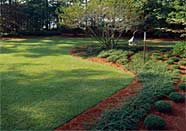

 |
 |
|
|
One of the common problems we encounter in early summer on St. Augustine
grass is a leaf spot disease called Gray Leaf Spot. Gray leaf
spot develops rapidly with abundant moisture and warm temperatures on St.
Augustine grass. It is especially troublesome in shaded areas that remain
damp for prolonged periods of time, or in low-lying spots, or where water
runoff flows regularly. Under these conditions, the disease can cause
serious thinning of the turf. Leaf spots first appear as tiny brown to ash- colored spots with purple
to brown margins that enlarge and become elongated or diamond-shaped.
Sections of the leaf blade will also turn yellow. In severe cases, lesions
develop on stems and spikes and the leaves wither and die. Turfgrass may
have a burned or scorched appearance resulting from death or spotting of the
leaf blades. Slime Mold. Another weather-related turf phenomenon is called
slime mold. You would think by the name we are talking about a slimy, gooey
condition on the grass. Actually, slime mold often appears as if ashes or
oil was deposited on the grass. Closer examination reveals a granular,
crusty or powdery material moving up the blades of grass from the thatch and
soil surface. The good news is that slime mold is not harmful to grass, but because it
is so visible, it creates concern. Slime mold lives most of its life cycle
unseen, breaking down and feeding on organic matter in the thatch and on the
surface of the soil. When environmental conditions are just right, it goes
from its vegetative state to a reproductive mode. This is when the light
colored to dark gray to black spore masses become visible. It moves up any
type of support, in this case grass blades, and turns into a large mass of
spores that are then blown in the wind and transported in runoff water. The
spores easily rub off on your shoes or hand when touched. Call us at 454-7336
|
|
Copyright © 2007 . - (512) 454-7336 |